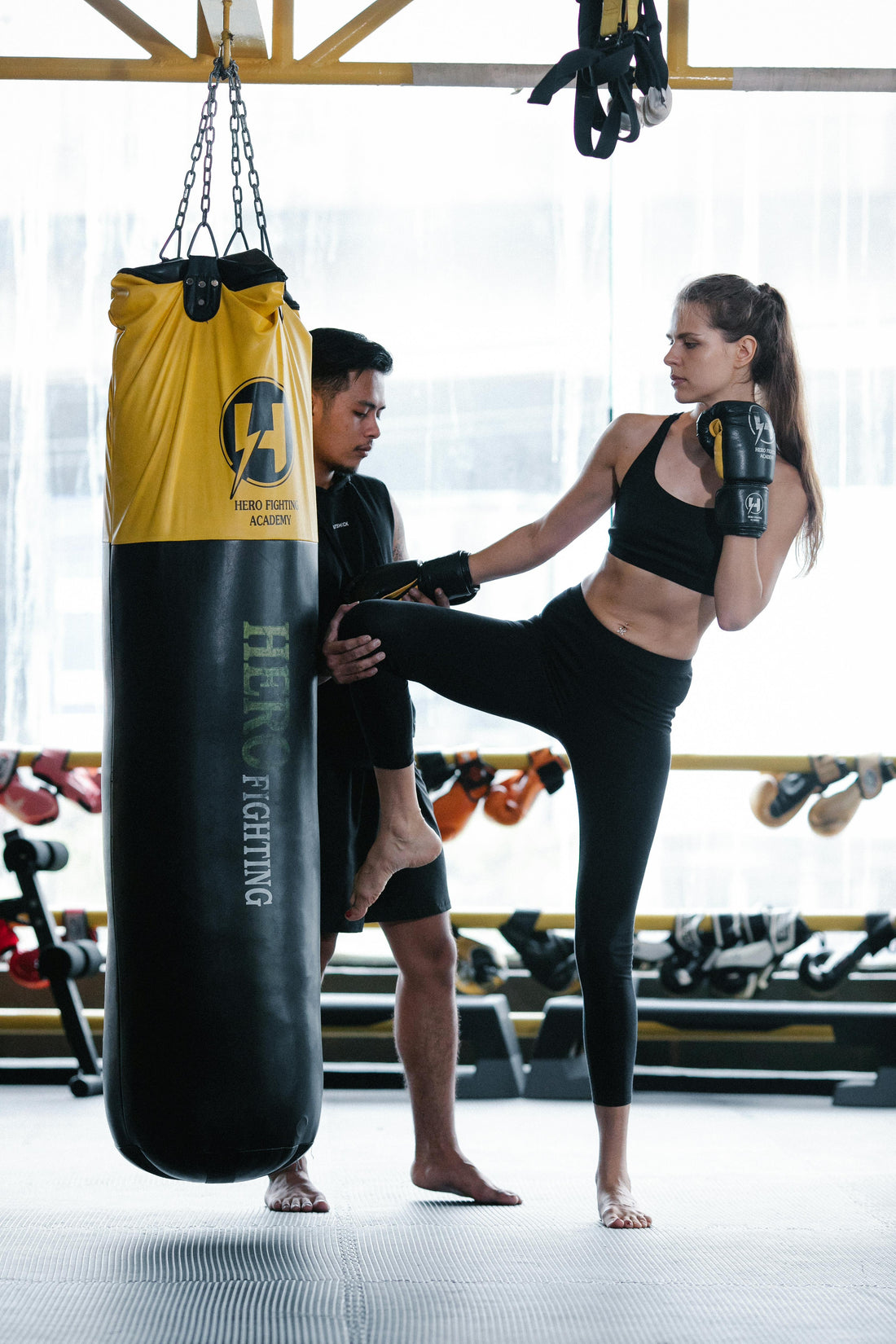
Kickboxing Fitness – Potentially the Most Versatile Fitness Activity!
Kickboxing fitness is a workout program that utilizes training techniques, movements, and combinations of movements from boxing, karate, kickboxing, and self-defense training. The versatility and flexibility of this type of program allows an instructor to create an exercise routine that is tailored to the demands and expectations of a target audience!
Instructors/trainers are evaluated on their abilities and capabilities to provide safe (avoidance of injury) and effective (experiencing the most benefit, based on specific, defined goals and objectives) training routines and programs to potential participants who may have a broad range of skills, physical conditioning, and levels of function.
Kickboxing or Boxing fitness training is not intended to develop Fighters or Black Belts! The goal is to provide safe workouts in which each movement is fully utilized, to positively stress the body and achieve the desired exercise program objectives and/or individual's goal(s). Safety is important.
Competitive And Self-Defense Training Vs. Boxing/Kickboxing Fitness Training
Goals for a fitness /exercise activity utilizing boxing, kickboxing and martial arts techniques are very different from competitive fighter and/or self-defense training.
Competitive and self-defense training are primarily concerned with teaching the individual to deliver various strikes with the greatest potential power and speed – in a repetitive manner. The intention is to out-point, knock out or physically destroy (for self-defense) an opponent! The development of speed and power in technique execution, for a fighter, is important. However, there are no specific health/fitness benefits that result from this type of training. The competitive type of training does pose a greater potential for physical injury!
Concern for safety (defined as preventing injury resulting from improper technique execution) and health (defined as preventing disease through physical activity) is not the goal for the competitive fighter or self-defense training.
Boxing or kickboxing fitness training is primarily focused on providing safe and effective exercise activities for participants of all sizes, age, fitness levels, skill levels, gender type, functional capabilities and medical conditions. Training methods and movement execution must be evaluated and modified to be safe and effective for every participant.
Application of Exercise Science Principles
Like any other fitness training program, boxing and kickboxing fitness training should be designed and facilitated according to proven exercise science principles, to ensure the safest and most effective routines and activities.
FITT Principle
The FITT principle is an acronym that represents:
- Frequency – how often should the exercise routine be performed (typically stated in ‘sessions or workouts per week’).
- Intensity – how difficult or strenuous a workout session should be.
- Time – how long (duration of) a workout session should be.
- Type – the type of exercise (cardio, muscle conditioning, flexibility, etc.)
Specificity
The fitness principle of specificity states that the body's adaptation or change in physical fitness is specific to the type of training undertaken. To maximally improve muscle conditioning, you must perform resistance training. To maximally improve cardiovascular function, you must perform cardio-based exercise. To maximally improve any specific aspect of fitness or skill, you must perform specific activities that are applicable to the goal.
Progressive Overload
Progressive overload is the act of gradually increasing the demands of an exercise routine on the body.
SAID (Specific Adaptation to Imposed Demands Principle
The SAID principle states that the body will adapt to the specific demands placed upon it. In other words, you get what you train for. There must be a consistent stress placed on the body to make it adapt.
Periodization
Periodization is an overall concept of training that deals with the division of the training process into specific phases. Programming is the manipulation of the exercise variables within these phases that are needed to bring about the specific adaptations period.
Fitness Components
Boxing and kickboxing fitness combines and modifies martial arts and boxing techniques and movements into a dynamic exercise program. There are many aspects of health and fitness that can be potentially improved through this method of training including cardiovascular function, muscular function, flexibility, coordination, agility, reaction time, balance, brain health/cognitive function, emotional and mental health.
Cardiovascular Conditioning
Cardiovascular conditioning is achieved through the repetitive performance of physical movement that elevates heart rate. Boxing and kickboxing training is typically promoted as super high intensity workouts – but they can be easily designed and/or modified, based on the participants’ needs (safety and effectiveness), to improve:
- Aerobic (low to moderate intensity) cardiovascular function (endurance),
- Anaerobic (high intensity) cardiovascular function (power).
Workouts can be formatted as steady state (continuous activity at low to moderate intensity levels) or as interval training (LIIT, MIIT, or HIIT) with work/rest periods determined by the fitness levels of the participants and the specific program goals. Aerobic and anaerobic workouts can be performed in Group or Circuit Training formats.
Muscular Conditioning
Muscular conditioning for muscle function (stabilization, endurance, strength, and power) is improved and maintained by performing movements against a resistance (a force opposing the movement), both directly and indirectly.
Resistance can be applied against any boxing/kickboxing movement pattern. Because these joint movements can be performed through any plane or angle, they are more functional than movement patterns used in more traditional forms of exercise. Overall muscle conditioning is greater because of the application of resistance against a variety of joint movements and positions, instead of in one main movement path (plane and angle). These unique movement patterns will better prepare the body (Specificity principle) for daily function.
The type of muscle conditioning that will be experienced is influenced by manipulation of various training variables, including (but not limited to):
- Load (level of resistance)
- Repetitions
- Sets
- Rest between sets
- Joint positions (joints that are directly and indirectly involved in the movements)
- Type of resistance (gravity-dependent, non-gravity dependent, inertia, etc.)
Flexibility
Due to the nature of boxing/kickboxing movement patterns, flexibility training for the whole body is enhanced. The wide variety of movement patterns, which occur at many different joint angles, require muscles and connective tissue to be elongated through the full range of motion of the involved joints.
Mobility
Mobility is the ability to move freely. Movement is caused and/or controlled by activated/functioning muscles being “told” what to do (and not do) by the brain and nervous system. Full range of motion movement may also be impacted by joint structures and connective tissue (ligaments, tendons, etc.). To maintain and/or improve the ability to “move freely,” we must MOVE all the joints in the body, in every possible movement pattern, through the greatest potential range of motion. This requires maximizing muscle function and flexibility! The very nature of boxing, kickboxing and martial arts training involves moving all joints of the body in every possible plane and angle of motion!
Balance, Coordination, Agility, and Reaction Time
Improved balance, coordination, agility, reaction time is a direct result of learning the specific movements and combinations of movements associated with boxing and kickboxing. Movement patterns tend to be unique compared to traditional fitness class choreography. Boxing and kickboxing movements, activities, drills, and routines can be manipulated to focus on specific improvements in balance, coordination, agility, and reaction time.
Brain Health/Cognitive Function
Brain health is enhanced through the same physiological responses that result from safe and effective exercise and physical activity.
Cognitive functions can be challenged in a variety of ways during a boxing/kickboxing fitness workout. The key is to keep the mind engaged during the workout – make the participants think while moving! One of the many, many ways to do this is by including reactive training in the workout. Have participants respond in a specific way to a specific stimulus or cue. One example would be to have participants execute a specific movement when the trainer provides a specific verbal or movement cue.
Stress relief can be an additional benefit of these workouts. What is a common reaction to an emotionally stressful situation? Clench the fists and hit a tabletop! Well, a major part of this workout consists of striking with hands, feet, knees, elbows, etc.! But the striking is done in a constructive manner - moving the body into a healthy and fit state!
Emotional & Mental Benefits
Emotional & Mental benefits may be experienced because of the physical training and the goals that are achieved. Some of these benefits include:
- Confidence & Self-Esteem – is developed by:
- Starting, maintaining, and experiencing the physical results of an exercise program. Confidence and self-esteem is enhanced when an individual recognizes improvements in physical appearance, capabilities, and abilities.
- Learning and mastering the new skills required to perform a boxing/kickboxing workout. A sense of accomplishment and internal power is developed as coordination and physical skills improve.
- Discipline relates to having the mental and emotional control to perform and complete required tasks. Maintaining a workout program promotes both the physical and emotional benefits. This is an indirect reinforcement for discipline development, which is required to maintain the program under any circumstances. The discipline achieved can positively impact other areas of personal and/or professional life.
- Respect is developed in two areas: 1) respect for oneself, 2) respect for others.
- Stress relief – think about! What is a normal reaction to something that causes negative stress? Do you clench your fist? Do you slam your clenched fist down on a table or hit a wall? Well, that is a normal response! The best thing to do is participate in a physical activity, like boxing or kickboxing, that includes “striking” something! Immediate (legal and non-destructive) stress relief! The emotional stress relief experienced is a key benefit in today’s world of “fast” paced and high-tension lifestyles.
Conclusion - Very Important:
Boxing/Kickboxing fitness classes DO NOT TEACH SELF DEFENSE. Fitness class or training clients learn, in a non-threatening environment, how to execute certain defensive movements and strikes.
A real conflict situation involves additional factors which influence learning practical, realistic, and effective street self-defense. To believe that one can learn real-life self-defense in a fitness class, is to create a false sense of confidence that could possibly have very negative results. The physiological AND emotional responses to a real attack are impossible to duplicate in a fitness class.
Some techniques and movement patterns are executed differently for self-defense than they should be for a fitness-based workout because of the specific goal(s) for the technique or movement pattern. The goal for fitness is to improve the function and condition of the body. The goal for self-defense is to subdue an attacker.
A fitness class can enhance physical conditioning that would be needed for performance of physical self-defense (anaerobic conditioning with muscle endurance/strength/power conditioning).
A fitness class can be used to practice and improve some (but not all) physical skills (some striking, blocking, evasion, balance, agility, reaction, etc.), but not under the physiological duress of a realistically simulated attack that would happen in a real self-defense training.
You don’t learn how to get out of various types of grabs & holds or how to fight while on the ground or in any other potential environment. And an important part of self-defense training includes the development of mental, emotional, environmental, AND physical awareness.
So, I repeat - Boxing/Kickboxing fitness classes DO NOT TEACH SELF DEFENSE. But these workouts are potentially THE most versatile fitness activity you can participate in!
CHECK OUT in our store – Tim Rochford’s other courses with W.I.T.S. AT https://witseducation.com/products/personal-safety-self-defense-instructor-training-by-empowerusa?_pos=1&_psq=self+defen&_ss=e&_v=1.0 AND https://witseducation.com/products/kickboxing-fitness-instructor-training-by-empowerusa?pr_prod_strat=e5_desc&pr_rec_id=712848f4b&pr_rec_pid=9027238428973&pr_ref_pid=9027238461741&pr_seq=uniform
